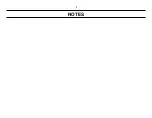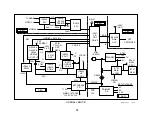
3
Monitor
Spec
1024
1800
1024 x 1800 pixels
X
TV
Spec
1080 x 1920 lines
X
Interlaced Scan
Field 1
+
Field 2
=
Frame
Progressive Scan
Field 1 =
Frame
DTV Converter Boxes
In order to compare converter box specifications you need to understand
how resolution is measured in the interlaced and progressive scan meth-
ods. With this information you can also determine which one of the 18
digital formats offers better resolution.
Resolution
The two most popular methods of measuring picture resolution are in
pixels (dots) or in lines. Incremental dots called pixels are often associ-
ated with monitors. Lines of resolution is a measurement for TVs. In the
monitor specifications, the number of vertical pixels is listed first. In the
TV specifications, the number of horizontal lines is listed first. For these
examples of specifications, a high-resolution monitor and (digital) TV stan-
dard were chosen:
Although the semantics are different (vertical pixels/horizontal lines), the
first number in both specifications is the maximum number of black to
white transitions that can occur as you count from the top of the screen to
the bottom.
In the current NTSC (National Television Standards Committee) TV trans-
mission standard, 525 horizontal lines are transmitted but only about 480
lines are visible. This is because the vertical blanking area above the
picture is not seen and the picture is normally over-scanned (larger than
the TV screen). Therefore, the TV resolution is said to be “480” (horizon-
tal) lines instead of the transmitted 525 lines.
USA Analog Transmission Format
Interlaced and Progressive Scanning
In the NTSC television transmission format a complete picture (frame)
consists of two pictures (fields) interlaced together. Each half picture is a
field of 262.5 scanned lines. Therefore a complete picture is 262.5 x 2 =
525 lines. The two scanned fields are interlaced so the second field of
262.5 lines fits in-between the first field.
If a picture is not interlaced, it is a progressive scan image (not NTSC
format). This means the entire picture frame is presented in the first scan
and a second picture is presented in the second scan.
30 or 60 Frames?
In the NTSC standard the first field takes 1/60 second to scan a screen of
262.5 lines. Then a slightly smaller vertical sync pulse in the second field
is created and the second picture field is shifted lower than the first to fit
in-between. The second field also takes 1/60 sec., completing the entire
picture frame in 1/60 + 1/60 = 2/60 sec = 1/30 sec.
Summary of Contents for KV-32XBR400
Page 1: ......
Page 5: ...1 NOTES ...
Page 12: ...8 NOTES ...
Page 14: ...10 NOTES ...
Page 83: ...APPENDIX ...








































